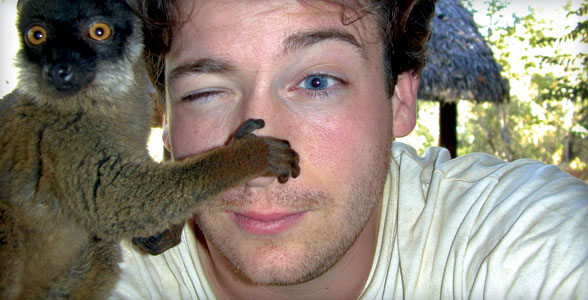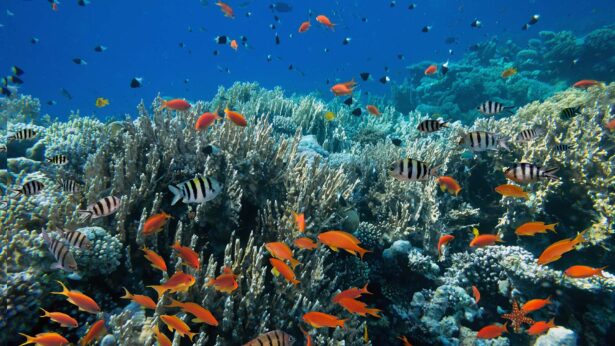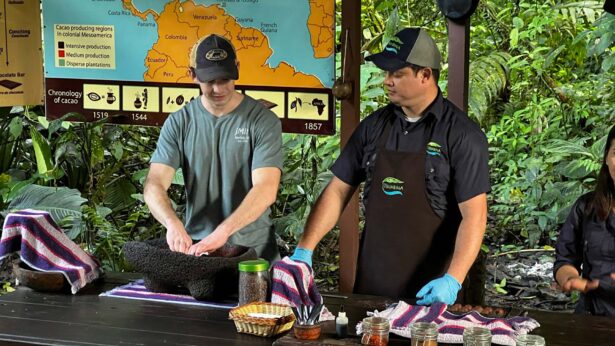Ask conservation ecologist Dr. Luke Dollar to describe the moment when he felt farthest removed from the University of Tennessee campus, and he’ll likely cite Madagascar, where he’s logged nearly 6 years researching mammalian predators. Chief among them is the enigmatic fossa (pronounced “FOO-suh”), a 20-pound carnivore that blends a mountain lion’s agility and cunning with the sheer bellicosity of a mongoose.
Dollar might mention a particularly memorable night in a tent in the forests of Ankarafantsika National Park, miles from the nearest medical aid, when a rapidly spiking fever and uncontrollable shaking indicated his malaria had recurred for the fourth time in a single research season.
Or he might describe his bout with cholera, which, with the characteristic understatement of an intrepid explorer, he terms “pretty rough.” Then, of course, there’s his tooth, broken off down to the pulp, that abscessed for want of a qualified dentist.
“Conditions today in parts of Madagascar are similar to what you might have encountered in the United States in the early 1800s,” says Dollar, who was enrolled in the Ph.D. program in UT’s ecology and evolutionary biology department from 1998 to 2000.
But it’s Madagascar’s very wildness that makes the island–more than five times the size of Tennessee–a prime destination for Dollar and other scientists eager to conduct research in one of the richest repositories of animal and plant life on the globe.
Dollar’s scientific and conservation efforts on the island have established him as the world’s leading authority on the fossa and moved the notoriously exclusive National Geographic Society to select him as one of just eight “Emerging Explorers” for 2007. The honor, which includes a $10,000 cash award, has etched the 33-year-old’s name on the shortest of short lists for up-and-coming researcher-scholars. “Luke’s dedication to the study and conservation of Madagascar and specifically his cutting-edge fieldwork on the fossa epitomize the spirit of what it means to be a National Geographic Emerging Explorer,” says Susan Reeve, director of the society’s explorers program and special projects.
Dollar recalls with a mixture of pride and awe attending the society’s invitation-only Explorers Symposium in March. There he mingled with 30 or so living legends of research and exploration. “The Leakeys [the eminent anthropological dynasty that studies hominid fossils of East Africa] were on one side of me,” says Dollar, “and Paul Sereno [paleontologist and National Geographic explorer-in-residence] was on the other.” Robert Ballard, discoverer of the wreck of the HMS Titanic, sat just across the room.
An Island’s Riches Imperiled
If you think in metaphors, you might regard Madagascar as sort of a Noah’s ark of land that broke away from the southeastern coast of Africa and sailed 250 miles into the Indian Ocean, carrying with it a rich diversity of plant and animal life.
But slash-and-burn agriculture, on which nearly three-quarters of Madagascar’s 19 million people subsist, has taken an enormous toll on the island’s once expansive forests and has driven countless species–many of them found nowhere else–into extinction.
“Less than ten percent of the original eastern rainforests remain,” laments Dollar, who has tracked Madagascar’s declining forests via satellite imagery. Only 3 percent of the original dry forests of the west survive.
“It’s not possible to be in Madagascar and have a conscience–and be conscious–and not realize that if you don’t do something about conservation in the remote places where field biologists work, we’re all going to wind up with a bunch of data on extinct creatures by the ends of our careers,” he says.
Dollar’s conservational bent led him to the Earthwatch Institute, an international environmental organization that matches scientists with volunteers to conduct field research and promote environmental education. The institute, which seeks to explore and preserve the globe’s threatened ecosystems, appointed the then–24-year-old Dollar as the principal investigator–the youngest PI in its history–on his “Carnivores of Madagascar” program in 1998. He has served in that capacity ever since.
His abiding preoccupation with the fossa began with an untimely death that occurred shortly after he arrived on the island. A lemur Dollar was trying to track wore a nonfunctioning radio collar left over from an earlier research effort. One day, as his research team’s radio receiver homed in on the steady pulse beamed by a lemur equipped with a more modern collar, a mysterious second tick began to emanate from the speaker. When the receiver indicated that they had located the source of the second tick, the researchers scanned the trees, hoping to spot the lemur. But the creature–or rather what was left of it–lay directly at their feet.
A few tufts of fur, some bone fragments, and a gnawed-up radio collar were all that remained of the hapless prosimian.
“A fossa got him,” pronounced a Âsomber-looking local guide.
“A what?” asked Dollar. The fact is, while the elusive fossa populate countless eerie Malagasy folktales, few islanders had actually seen one, and scientists knew virtually nothing about the top-ranking native predator on the island.
The fossa’s formidable teeth had resurrected the malfunctioning radio collar as they dispatched the lemur. “In the process of eating the lemur, the fossa had chomped on the radio transmitter and somehow reconnected the battery wires,” says Dollar.
Two years later, after Dollar’s research interests had shifted almost entirely to the fossa, a second untimely death inclined him to bolster his research with an aggressive educational campaign because–in this instance–the predator had become the prey.
As Dollar and his colleagues followed the tracking receiver’s steady blip on the trail of a fossa, the signal led them to a river near a small village, but there was no fossa to be seen. Dragging the river, Dollar recovered the fossa’s collar, which clearly had been cut rather than chewed off. “The fossa had strayed into the village and was killed,” Dollar says.
Rural villagers’ reliance on bush meat, as well as their culturally grounded fear of the fossa, continues to thin the fossa’s population, which has dwindled to less than 2,500. “Ironically, if you ask Malagasy villagers about major problems, they’ll mention wild pigs destroying their crops and rats raiding their food stores,” Dollar says. “And what do fossas eat? Pigs and rats.”
Dollar feels a part of Malagasy culture, having invested nearly a third of his life there. For him, the highest compliment on the value of his work didn’t come from the National Geographic Society or Earthwatch or any of the environmental nonprofits that have celebrated his efforts. It was, in fact, a compliment he was never meant to hear.
Walking down a dirt road one day, on his way to check one of his fossa traps, Dollar passed a Malagasy mother and her child. “It’s common for Malagasy kids to run after anyone who looks like me and yell, ‘Vazaha! Vazaha!,’ an epithet that means ‘light-skinned foreigner,’ ” he says. The mother quickly hushed–then corrected–her child: “Tsy vazaha izy; gasy footsy isy,” she whispered. “He is not a foreigner; he’s a white Malagasy.”
Larger-Than-Life Killer
Next to the top of the food chain on the island of Madagascar crouches the fossa (Cryptoprocta ferox), a fierce carnivore about the weight of a cocker spaniel, bested by only the Nile crocodile, a non-native species more than 50 times the fossa’s size. The fossa resembles a miniature puma equipped with the tenacity and long, lean lines of a mongoose.
The fossa was originally described in the 1860s, after early naturalists shot one, but more than 130 years would pass before scientists, with UT alumnus Luke Dollar at the helm, launched a sustained effort to study their habits, habitat, and surviving numbers.
A mere 500 years ago, the modern fossa’s recent ancestor, Cryptoprocta spelia, possibly grew to 6 feet in length (not counting the tail), weighed as much as 200 pounds, and ruled the island, feeding on equally outsized lemurs, which then grew as large as modern gorillas.
So fearsome was the hulking C. spelia that it entered the realm of myth. Malagasy mothers still bid their children to behave, or the fossa will snatch them from their beds and devour them.
Luke Dollar and UT’s Ecology Dream Team
Luke Dollar’s ascension into the elite ranks of the planet’s explorers began humbly–with a scoop shovel–at the Duke University Primate Center, where as an undergraduate, he cleaned up behind the largest captive colony of lemurs in the world.
In 1994 Dollar was a research assistant on an expedition to the eastern rainforests of Madagascar. The focus of their study: the lemur, a bug-eyed primate of the class prosimians. After he had graduated with a bachelor’s degree in anthropology from Duke, his quest to find the best research faculty in the field of predatory ecology led him straight to the University of Tennessee and professors John Gittleman, Daniel Simberloff, Stuart Pimm (ecology and evolutionary biology), and Mike Pelton (forestry, wildlife, and fisheries).
“I could have gone anywhere in the country or on earth to find the advisors and faculty that I needed in a perfect combination for what I wanted do,” says Dollar. “The one place that had it all was Knoxville. The combination of outstanding professors and being next door to the Great Smoky Mountains, a living laboratory, was exactly what I needed to launch my research career.”
Dollar spent 2 years in the graduate program at UT before following Pimm, first to Columbia University and then to Duke, where Dollar earned M.S. and Ph.D. degrees in ecology.
Dollar is now on the faculty of Pfeiffer University, where he serves with UT alumnus Dr. Lance Riddle (Ph.D. 2006), who replaced Dr. Don Jackman, also a UT alumnus, in the chemistry department.



